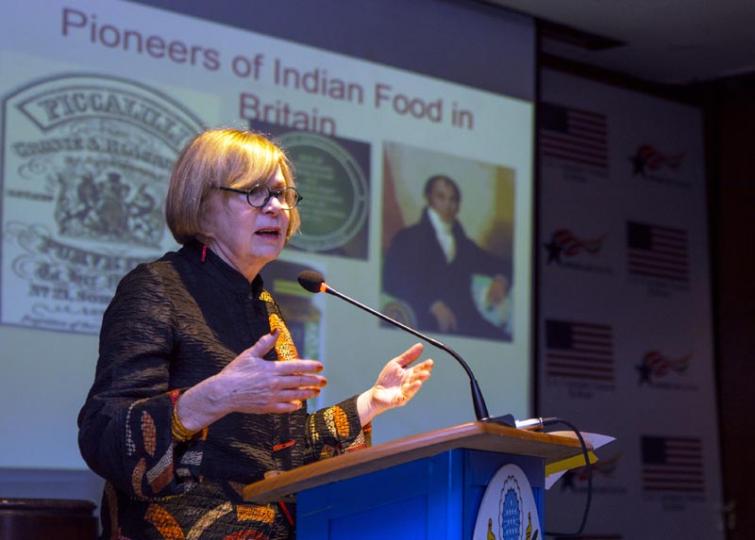
30 pc Americans love Japanese food: US food historian and Indian cuisine expert Colleen Taylor Sen
Food historian Colleen Taylor Sen is a Canadian American translator and author specializing in Indian cuisine. She has written six books, and has also contributed entries to many encyclopedias. She was one of the guests at the American Center in Kolkata for Tasting India Symposium's first ever event “India’s Global Foodprint: New Discoveries”. In an exclusive chat on sidelines with IBNS correspondent Sanya Anand at American Center, she spoke about her experiences
Colleen Taylor Sen explored the history of Indian food in the United States from the arrival of the first Asian Indians in the early 17th century to the present. A central theme was the evolution of Indian restaurants from the early British-themed “curry houses” through the standard Tandoori-North Indian establishments of the 1960s and 70s to today’s progressive globally inspired restaurants. She delivered the keynote address, “Pakoras, Paneer, Pappadums: Decoding Indian Restaurants in the U.S.” as an advisory board member of Tasting India Symposium in Kolkata. Excerpts:
You have written books like Feasts and Fasts on Indian cuisine. What is your research process behind writing a book?
I just keep looking at other books and get references, go online and browse through Wikipedia, thereby gathering good references and I have also got a huge collection of books which I usually prefer.

Tell us about Feasts and Fasts: A History of Food in India.
The second most populous country in the world after China and the seventh largest in area, India is unique among nations in its diversity of climates, languages, religions, tribes, customs and cuisines. Today, Indian food in its many incarnations has become a world cuisine. This reflects an increased awareness of the virtues of a traditional Indian diet, especially the centrality of fruits, vegetables and grains and the extensive use of spices, the benefits of which have been confirmed by modern science. The global nature of Indian cuisine is not new. For thousands of years, the Subcontinent was the centre of a vast network of land and sea trade routes – conduits for plants, ingredients, dishes and cooking techniques to and from the rest of the world. My book is an exploration of Indian cuisine in the context of the country’s religious, moral, social and philosophical development. It addresses topics such as dietary prescriptions and proscriptions, the origins of vegetarianism, culinary borrowings and innovations, the use of spices and the inseparable links between diet, health and medicine. It also looks at special foods for festivals, street foods and the splendour of Mughal feasts.

Do you think that street food is as important in America as in India?
Street food in America is a very dicey subject because there is a lot of struggle with the authorities and in maintaining the license of food trucks as well.
As you have written your book regarding different cuisines, which is your go to street food?
This is a bit difficult one for me to answer but if I think I really like Vada pav (vegetarian fast food dish native to the state of Maharashtra consisting of a deep fried potato dumpling placed inside a bread bun sliced almost in half through the middle) which I tried in Mumbai and visited like five different places to try it.

Now that veganism and sustainability is trending, could this possibly create an upsurge in demand and popularity for Indian cuisine?
There has been a demand and attraction for Ayurveda, for example turmeric, satvik food but not in the mainstream and is mostly famous as entree and surely in the future its demand will be high. But how much is still a question because it depends on many factors, like economy of a country, perception of a country to the world which influences peoples’ choice and willingness to pay a lot of money.
So which international cuisine is predominant in USA?
In America about 30% people love Japanese cuisine which is basically raw fish ( sushi, etc.) whereas Indian food do not have much demand as they feel the Indian food is too spicy and oily. They feel it is not much healthy.
Support Our Journalism
We cannot do without you.. your contribution supports unbiased journalism
IBNS is not driven by any ism- not wokeism, not racism, not skewed secularism, not hyper right-wing or left liberal ideals, nor by any hardline religious beliefs or hyper nationalism. We want to serve you good old objective news, as they are. We do not judge or preach. We let people decide for themselves. We only try to present factual and well-sourced news.







